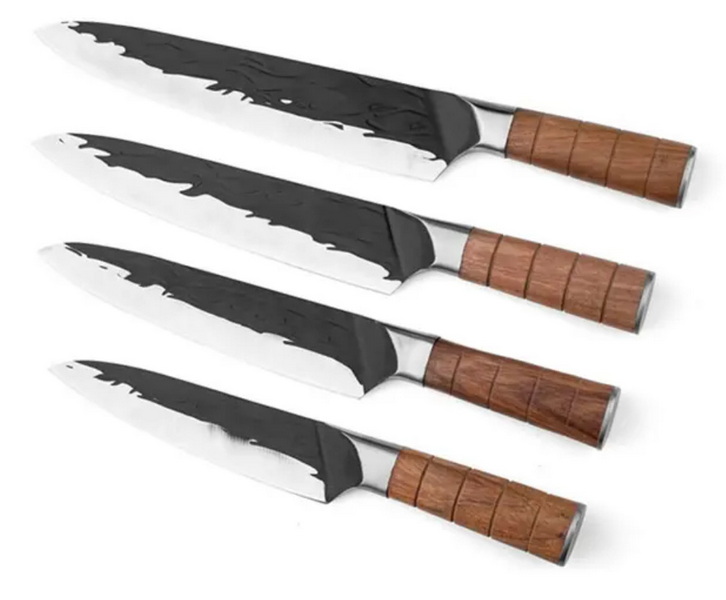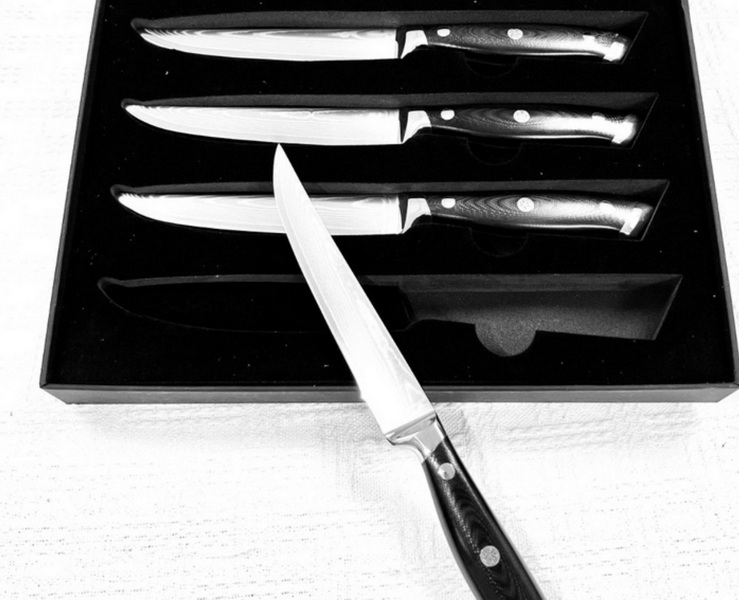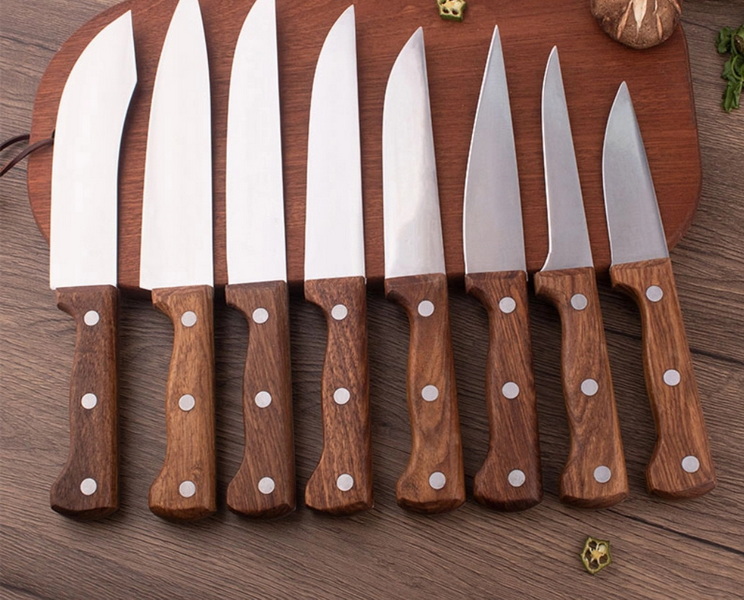- All
- Product Name
- Product Keyword
- Product Model
- Product Summary
- Product Description
- Multi Field Search
Views: 222 Author: Ann Publish Time: 2025-10-30 Origin: Site











Content Menu
● Overview of SAAFI Steak Knives
● Material Choices and Blade Construction
● Handle Design and Ergonomics
● Manufacturing Process and Quality Control
● OEM/ODM Customization Pathways
● Branding and Marketing Implications
● Practical Real-World Considerations for OEM Buyers
● Extended Case Studies and Guidance
● Sustainability and Compliance Considerations
● Global Market Adaptation Insights
>> Q1: What makes SAAFI steak knives suitable for OEM partnerships?
>> Q2: Can we customize blade shapes and handle materials?
>> Q3: What is the typical lead time for OEM orders?
>> Q4: How is quality assurance managed?
>> Q5: Do you provide post-sales support and spare parts?
SAAFI steak knives represent a compelling blend of performance, durability, and design versatility for OEM/ODM buyers seeking reliable kitchen tool solutions. As a China-based factory specializing in high-quality kitchen knives, we understand the critical needs of foreign brands, wholesalers, and manufacturers: consistent blade hardness, balanced ergonomics, safe packaging, scalable customization, and efficient supply chains. This article examines why SAAFI steak knives are a smart choice for OEM/ODM partnerships, with practical guidance on material selection, manufacturing processes, quality controls, and branding considerations. Throughout, the term steak knife appears frequently to reinforce relevance for professional kitchens and premium home use.

SAAFI steak knives are engineered to deliver precision cutting, edge retention, and comfortable handling across diverse cooking styles. For OEM/ODM buyers, the key advantages include:
- Consistent blade geometry and finish across large production runs
- Flexible customization options for logos, packaging, and blade markings
- Compatibility with various handle materials and scales to meet regional preferences
- Robust supply stability supported by a dedicated manufacturing backbone in China
- Competitive total cost of ownership when factoring in lifecycle durability and after-sales support
A steak knife's performance hinges on blade steel, heat treatment, and edge geometry. SAAFI typically offers:
- High-carbon stainless steel blades for corrosion resistance and edge stability
- VG-series or equivalent premium steels for superior wear resistance
- Forged vs stamped blade options, with forged blades offering better grain structure and strength
- Optional full tang construction for enhanced balance and durability
- Edge geometry optimized for fine slicing of meats, including beef, poultry, and fish
In practice, OEM buyers should consider:
- Blade hardness targets (HRC values) aligned with end-use expectations
- Corrosion resistance in target markets (humid coastal regions vs dry interiors)
- Compatibility with dishwasher-safe packaging and home-use care guidelines
- Maintenance expectations, including sharpening intervals and tool longevity
The handle is often the most felt aspect of a steak knife. SAAFI offers a range of handle options, including:
- Stainless steel, pakkawood, laminated composite, and resin-based scales
- Ergonomic shapes that reduce fatigue during long service periods
- Full tang and triple-rlex construction for improved control
- Color and texture options to support branding and regional aesthetics
For OEM buyers, the goal is to match consumer preferences in each market while ensuring manufacturability at scale. Consider handle materials that balance aesthetics, grip comfort, moisture resistance, and cost.
- Ergonomic testing data can inform the preferred handle geometry for professional kitchens versus home use
- Environmental considerations, such as sustainable wood sourcing and low-emission curing processes, can enhance branding
To ensure consistent supply for OEM/ODM engagements, a robust production framework matters. SAAFI's typical process includes:
- Raw material verification and supplier qualification
- Precise forging or stamping with controlled temperature profiles
- Controlled quenching and tempering to achieve target hardness and toughness
- Surface finishing processes such as mirror polish or satin grind
- Laser etching or mechanical stamping for logos and branding
- Rigorous dimensional inspection and blade-balance testing
- Final packaging that preserves blade integrity during transit
Quality control checkpoints to emphasize with partners:
- Incoming material inspection for blade steel and handle components
- In-process metrology for blade straightness and thickness
- Edge retention testing and corrosion resistance checks
- Thermal cycling and drop testing for packaging compatibility
- Final visual and functional inspection prior to shipment
OEM/ODM buyers seek differentiation through branding, packaging, and product features. SAAFI supports several customization routes:
- Brand logos on blades via laser engraving or etching
- Custom blade profiles (grinds, bevel angles) to suit regional culinary practices
- Handle variations (material, color, texture) to align with brand identity
- Packaging customization, including retail-ready boxes, sleeves, and inserts
- Value-added options such as built-in sharpeners integrated into knife blocks or sets
Design for manufacturability considerations:
- Tolerances aligned with mass production slack
- Standardized components to reduce SKU complexity
- Supplier-ready packaging materials to minimize damage in transit
- Clear guidelines for consumers on care and maintenance to maximize product life
A strong brand story enhances OEM/ODM success. For steak knives, consider narratives around:
- Culinary heritage and craftsmanship
- Material science and performance testing
- Safety and user-friendly design for home kitchens and professional environments
- Sustainability and ethical sourcing practices
Marketing-ready content should weave in the keyword steak knife naturally and effectively, without compromising readability. High-quality imagery and instructional videos demonstrating slicing performance, maintenance, and safe handling will resonate with international buyers.
- Regional requirements: Different markets demand different blade angles, packaging standards, and regulatory labels. Ensure compliance across target regions.
- Lifecycle cost: Evaluate not only the upfront price but also expected blade life, sharpening frequency, and warranty terms.
- After-sales support: Provide clear replacement policies, spare parts availability, and training resources for distributors.
- Packaging and protection: Use packaging that minimizes nicks and corrosion while presenting premium appeal.
- Logistics: Coordinate lead times, freight terms, and import duties to maintain reliable supply.

To provide actionable insights, consider including case studies that illustrate successful OEM collaborations. For example:
- Case A: Brand X required a brushed stainless steel finish with a pakkawood handle and laser-etched branding. The production line was adjusted to accommodate a new handle resin supplier and a revised packaging artwork, achieving a 20% decrease in lead time and a 12% reduction in defect rate due to tighter tolerances.
- Case B: Brand Y demanded a sportier handle color palette and a different blade bevel for regional meat-cutting variations. Our team developed a modular blade geometry library, enabling rapid SKU creation without sacrificing quality, resulting in faster time-to-market by 4–6 weeks.
- Case C: Brand Z integrated a built-in steel sharpener into a knife block set. The project required integrated testing for blade-edge retention after repeated sharpenings and adjusted resin compounding for temperature stability, delivering a seamless consumer experience.
- Material sourcing: Emphasize certified suppliers, recycled content where feasible, and responsible wood sourcing.
- End-of-life: Provide guidance on recycling packaging and compatibility with common disposal streams.
- Regulatory compliance: Align with safety standards in target markets, including labeling, dishwasher safety, and chemical testing where applicable.
- North America: Preference for ergonomic grips, durable stainless steel, transparent warranty terms, and branding that emphasizes safety and professional-grade performance.
- Europe: Emphasis on sustainability, packaging minimalism, and multifunctional sets that appeal to compact kitchens.
- Asia-Pacific: Value-focused options with cost-effective materials, durability, and regional customization.
- Middle East and Africa: Preference for corrosion resistance in hot, humid environments and serviceable spare parts networks.
SAAFI steak knives offer a compelling combination of performance, customization flexibility, and manufacturing reliability that OEM/ODM buyers crave. By leveraging our control over blade steel selection, heat treatment, handle options, and branding capabilities, foreign brands can accelerate time-to-market while delivering a premium product that resonates with professional kitchens and home cooks alike. With a strong focus on quality assurance, multimedia-rich product storytelling, and scalable production, SAAFI steak knives stand as a smart and practical choice for OEM/ODM partnerships in the global kitchenware market.

A1: Consistent blade geometry, reliable hardness, flexible customization, and scalable production with strong quality control.
A2: Yes. We offer a range of blade profiles and handle options, with branding opportunities such as laser engraving.
A3: Lead times vary by volume and customization, but we provide a clear production schedule and milestone tracking.
A4: Through incoming material checks, in-process inspections, and final testing, followed by packaging and shipment QA.
A5: Yes. We offer warranty terms, replacements, and access to spare parts as part of a comprehensive service package.
The Ultimate Professional Knives for Halal Butchery in Middle Eastern Kitchens
Chef Knife Size Guide: Choosing Between 6″, 8″, 10″, And 12″
Custom Knife Handles: How To Design A Chef Knife That Fits Your Hand Perfectly
Chef Knife Surface Treatments Guide: From Polished Migaki To Damascus Patterns
Inside Our Professional Knife Sample Room: Quality You Can See
Universal Knife Block Buying Guide: Modern Acrylic & ABS Knife Holders for Professional Kitchens
Universal Knife Block: The Complete Guide To Modern, Hygienic Knife Storage
The Complete Guide To Red Handle Knife Sets: Style Meets Functionality in The Kitchen
Professional Knives for Halal Butchery And Middle Eastern Cuisine